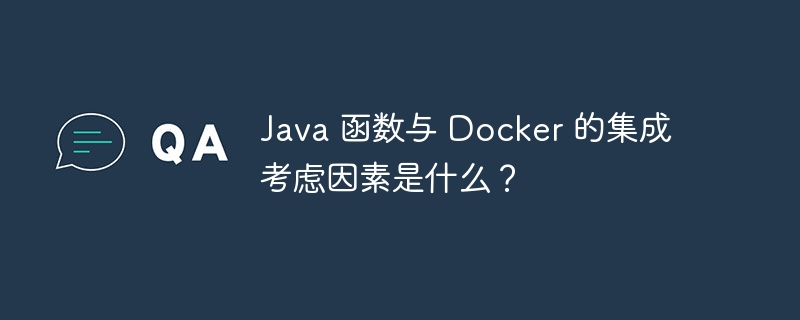What are the integration considerations for Java functions with Docker?
Things to consider when integrating Java functions with Docker: Make sure the Docker image supports running Java applications. Use Docker environment variables to configure Java settings in the container environment. Specify a mapping between container and host ports to enable external access to Java functions. Use Docker resource limits to control the CPU and memory used by containers. Use volume mounts to mount files and directories on the host into a container. The Docker build process should package Java code, dependencies, and container configuration, and then deploy via an orchestration tool such as Docker Compose or Kubernetes.

Integration considerations for Java functions and Docker
When integrating Java functions and Docker, the following factors should be considered:
1. Language support:
Ensure that the Docker image supports running Java applications. Common Java containers include OpenJDK and AdoptOpenJDK.
FROM openjdk:11 COPY my-app.jar /app.jar CMD ["java", "-jar", "/app.jar"]
2. Environment variables:
Use Docker environment variables to configure Java settings in the container environment, for example:
ENV JAVA_OPTS="-Xmx512m -Xms256m"
3 . Port mapping:
Specify the mapping between container and host ports to enable external access to Java functions. For example:
-p 8080:8080
4. Resource limits:
Use Docker resource limits to control the CPU and memory used by the container. For example:
--memory=512m --cpus=0.5
5. Volume mounting:
Use volume mounting to mount files and directories on the host into the container. This is useful for sharing code, data or configuration. For example:
-v /host/path:/container/path
6. Build and deploy:
The Docker build process should package the Java code, dependencies, and container configuration. The built image is pushed to the registry and can then be deployed via orchestration tools such as Docker Compose or Kubernetes.
Practical case:
Suppose you have a simple Java function named my-app.jar using Spring Boot. To deploy it as a Docker container:
- Create
Dockerfile:
FROM openjdk:11 COPY my-app.jar /app.jar ENTRYPOINT ["java", "-jar", "/app.jar"]
- Build the image:
docker build -t my-app .
- Run the container:
docker run -p 8080:8080 my-app
The Java function is now exposed as a Docker container on port 8080.
The above is the detailed content of What are the integration considerations for Java functions with Docker?. For more information, please follow other related articles on the PHP Chinese website!

Hot AI Tools

Undresser.AI Undress
AI-powered app for creating realistic nude photos

AI Clothes Remover
Online AI tool for removing clothes from photos.

Undress AI Tool
Undress images for free

Clothoff.io
AI clothes remover

Video Face Swap
Swap faces in any video effortlessly with our completely free AI face swap tool!

Hot Article

Hot Tools

Notepad++7.3.1
Easy-to-use and free code editor

SublimeText3 Chinese version
Chinese version, very easy to use

Zend Studio 13.0.1
Powerful PHP integrated development environment

Dreamweaver CS6
Visual web development tools

SublimeText3 Mac version
God-level code editing software (SublimeText3)

Hot Topics
 How to exit the container by docker
Apr 15, 2025 pm 12:15 PM
How to exit the container by docker
Apr 15, 2025 pm 12:15 PM
Four ways to exit Docker container: Use Ctrl D in the container terminal Enter exit command in the container terminal Use docker stop <container_name> Command Use docker kill <container_name> command in the host terminal (force exit)
 How to copy files in docker to outside
Apr 15, 2025 pm 12:12 PM
How to copy files in docker to outside
Apr 15, 2025 pm 12:12 PM
Methods for copying files to external hosts in Docker: Use the docker cp command: Execute docker cp [Options] <Container Path> <Host Path>. Using data volumes: Create a directory on the host, and use the -v parameter to mount the directory into the container when creating the container to achieve bidirectional file synchronization.
 How to restart docker
Apr 15, 2025 pm 12:06 PM
How to restart docker
Apr 15, 2025 pm 12:06 PM
How to restart the Docker container: get the container ID (docker ps); stop the container (docker stop <container_id>); start the container (docker start <container_id>); verify that the restart is successful (docker ps). Other methods: Docker Compose (docker-compose restart) or Docker API (see Docker documentation).
 How to check the name of the docker container
Apr 15, 2025 pm 12:21 PM
How to check the name of the docker container
Apr 15, 2025 pm 12:21 PM
You can query the Docker container name by following the steps: List all containers (docker ps). Filter the container list (using the grep command). Gets the container name (located in the "NAMES" column).
 How to start mysql by docker
Apr 15, 2025 pm 12:09 PM
How to start mysql by docker
Apr 15, 2025 pm 12:09 PM
The process of starting MySQL in Docker consists of the following steps: Pull the MySQL image to create and start the container, set the root user password, and map the port verification connection Create the database and the user grants all permissions to the database
 How to start containers by docker
Apr 15, 2025 pm 12:27 PM
How to start containers by docker
Apr 15, 2025 pm 12:27 PM
Docker container startup steps: Pull the container image: Run "docker pull [mirror name]". Create a container: Use "docker create [options] [mirror name] [commands and parameters]". Start the container: Execute "docker start [Container name or ID]". Check container status: Verify that the container is running with "docker ps".
 How to update the image of docker
Apr 15, 2025 pm 12:03 PM
How to update the image of docker
Apr 15, 2025 pm 12:03 PM
The steps to update a Docker image are as follows: Pull the latest image tag New image Delete the old image for a specific tag (optional) Restart the container (if needed)
 PHP's Impact: Web Development and Beyond
Apr 18, 2025 am 12:10 AM
PHP's Impact: Web Development and Beyond
Apr 18, 2025 am 12:10 AM
PHPhassignificantlyimpactedwebdevelopmentandextendsbeyondit.1)ItpowersmajorplatformslikeWordPressandexcelsindatabaseinteractions.2)PHP'sadaptabilityallowsittoscaleforlargeapplicationsusingframeworkslikeLaravel.3)Beyondweb,PHPisusedincommand-linescrip






